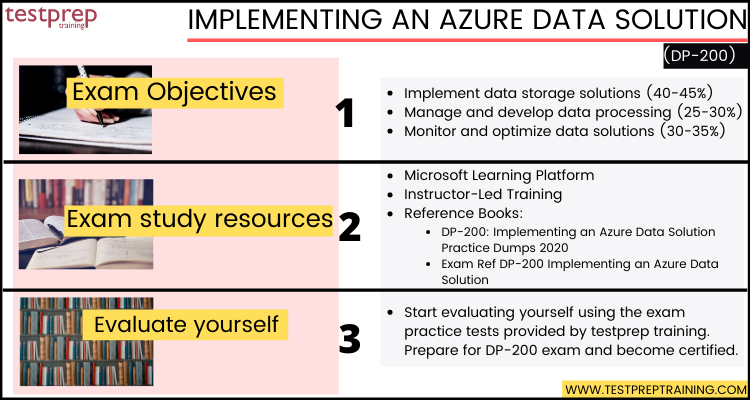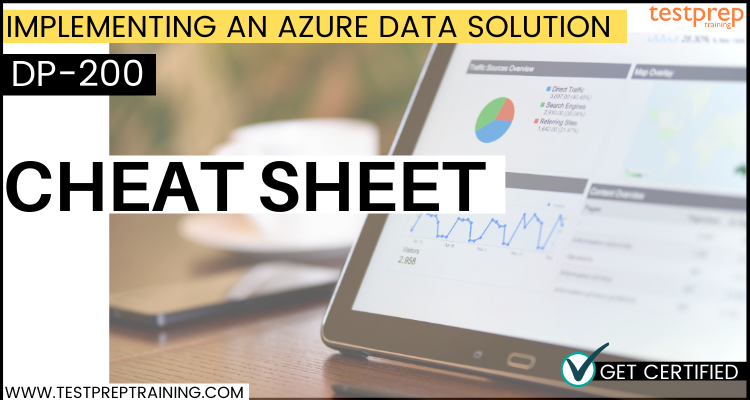Are you on your way to appear for the Implementing an Azure Data Solution (DP-200) exam and looking for a quick revision guide? Guess what, you have arrived at the right place. The purpose of this cheat sheet is to provide all the required resources and information for the DP-200 in a meaningful way. However, you have to pass both DP-200 and DP-201 exams to become Microsoft Certified Azure Data Engineer Associate. so, there is a need to enhance your knowledge in data solutions by practicing the Azure services such as Azure SQL Database, Azure Cosmos DB, Azure Stream Analytics, Azure Data Factory, Azure Databricks, Azure Data Lake Storage, and Azure Blob storage, etc.
Microsoft DP-200 exam is getting retired on June 30, 2021. A new replacement exam Data Engineering on Microsoft Azure Beta (DP-203) is available.
So, let’s begin with the cheat sheet and start understanding the basic requirements first!
About Implementing an Azure Data Solution (DP-200) Exam
Implementing an Azure Data Solution (DP-200) exam is best suitable for those who want to become Microsoft Azure data engineers and have ability to interact with business stakeholders for understanding and matching the data obligations to complete data solutions that practice Azure data services. However, for DP-200 exam there some exam requirement that says:
- Firstly, you must hold at least 1 year of background experience as business intelligence professionals, data professionals, or data architect.
- Secondly, you should also present capacities and skills for presenting content from data platform technologies on Azure.
Further, the DP-200 exam comes with a learning Path provided by Microsoft. So, you can through it in which you can test your knowledge in implementing data storage solutions, managing and developing data processing, and monitoring and optimizing data solutions.
Cheat Sheet for Implementing an Azure Data Solution (DP-200)
For better revision, it is important that you have all the required resources so that you are not left with anything. There are resources and suitable links provided below to quickly get a better understanding of the concepts as well as to clear all your doubts. So, let’s begin with this.

Review the Exam Objectives
This cheat sheet aims to offer a rapid review of information you are already familiar with. The key starting point is to focus on the exam objectives for the DP-200 exam. This approach will serve as a reminder and refresh your understanding of DP-200 topics and skills. Moreover, reviewing the exam objectives will leave no space for confusion in your head and you can focus onp further revisions. For Implementing an Azure Data Solution (DP-200) exam, below we will learn about the important topics. This include:
*Some changes in content for DP-200 Exam updated on 24 November, 2020.*
Implement Data Storage Solutions (40-45%)
1.1 Implement non-relational data stores
- Implement a solution that uses Cosmos DB, Data Lake Storage Gen2, or Blob storage (Microsoft Documentation: Creating Azure Cosmos DB Account, Implementing Solution using Blob Storage, Implementing a solution using Data Lake Storage Gen2)
- Implementing data distribution and partitions (Microsoft Documentation: Overview of Data Distribution with Azure Cosmos DB, Partitioning and horizontal scaling in Azure Cosmos DB)
- Then, Implementing a consistency model in Cosmos DB (Microsoft Documentation: Choosing the right Consistency Level in Azure Cosmos DB)
- Provision a non-relational datastore (Microsoft Documentation: Creating an Azure Cosmos account, database, container and Azure Portal Items)
- Provide access to data to meet security requirements (Microsoft Documentation: Securing access to data in Azure Cosmos DB)
- Lastly, implementing for high availability, disaster recovery, and global distribution (Microsoft Documentation: Azure Cosmos DB global distribution, Data restoring in Azure Cosmos DB)
1.2 Implement relational data stores
- Provide access to data to meet security requirements (Microsoft Documentation: Securing a database in Azure SQL Database)
- Implement for high availability, disaster recovery, and global distribution (Microsoft Documentation: Geo-distributed database (Azure SQL Database)
- Then, Implementing data distribution and partitions for Azure Synapse Analytics (Microsoft Documentation: Partition of tables in Synapse SQL pool, Designing distributed tables in Synapse SQL pool)
- Implement PolyBase (Microsoft Documentation: Loading data to Azure Synapse Analytics SQL pool)
1.3 Manage data security
- Implement data masking (Microsoft Documentation: SQL Database dynamic data masking)
- Lastly, Encrypting data at rest and in motion (Microsoft Documentation: Transparent Data Encryption in Azure Synapse Analytics)
Manage and Develop Data Processing (25-30%)
2.1 Develop batch processing solutions
- Develop batch processing solutions by using Data Factory and Azure Databricks
- Ingest data by using PolyBase
- Implement the integration runtime for Data Factory (Microsoft Documentation: Creating and configuring Azure Integration Runtime)
- Create linked services and datasets (Microsoft Documentation: Creating datasets, Creating Linked Service)
- Creating pipelines and activities (Microsoft Documentation: Creating Pipelines, Pipelines, and Activities in Azure Data Factory)
- Create and schedule triggers
- Implement Azure Databricks clusters, notebooks, jobs, and autoscaling (Microsoft Documentation: Cluster Size and Autoscaling)
- Ingest data into Azure Databricks (Microsoft Documentation: Extracting, transforming, and loading data using Azure Databricks)
2.2 Develop streaming solutions
- Configure input and output (Microsoft Documentation: Stream data as input into Stream Analytics, Azure Stream Analytics output to Azure Cosmos DB)
- Select the appropriate windowing functions (Microsoft Documentation: Stream Analytics windowing functions)
- Implement event processing by using Stream Analytics
Monitor and Optimize Data Solutions (30-35%)
3.1 Monitor data storage
- Monitor relational and non-relational data sources
- Implement Blob storage monitoring (Microsoft Documentation: Monitoring a storage account)
- Implementing Data Lake Storage monitoring (Microsoft Documentation: Accessing diagnostic logs for Azure Data Lake Storage Gen1)
- Implement Azure Synapse Analytics monitoring (Microsoft Documentation: Monitoring workload)
- Implementing Cosmos DB monitoring (Microsoft Documentation: Monitoring Azure Cosmos DB)
- Configure Azure Monitor alerts (Microsoft Documentation: Creating, viewing, and managing metric alerts using Azure Monitor)
- Implement auditing by using Azure Log Analytics (Microsoft Documentation: Auditing for Azure SQL Database and Azure Synapse Analytics)
3.2 Monitor data processing
- Monitor Data Factory pipelines (Microsoft Documentation: Monitoring and Alerting Data Factory with Azure Monitor)
- Monitoring Azure Databricks
- Monitor Stream Analytics (Microsoft Documentation: Monitor and manage Stream Analytics using Azure PowerShell cmdlets)
- Configure Azure Monitor alerts (Microsoft Documentation: Creating alerts for Azure SQL Database and Azure Synapse Analytics)
- Implement auditing by using Azure Log Analytics (Microsoft Documentation: Auditing for Azure SQL Database and Azure Synapse Analytics)
3.3 Optimize Azure data solutions
- Troubleshoot data partitioning bottlenecks (Microsoft Documentation: Strategies for Data partitioning)
- Optimize Data Lake Storage (Microsoft Documentation: Optimizing Azure Data Lake Storage Gen2)
- Optimizing Stream Analytics (Microsoft Documentation: Leveraging query parallelization in Azure Stream Analytics)
- Optimize Azure Synapse Analytics (Microsoft Documentation: Best practices for Synapse SQL pool in Azure Synapse Analytics)
- Manage the data lifecycle (Microsoft Documentation: Manage the Azure Blob storage lifecycle)
Microsoft Learning Platform
Microsoft offers various learning path for DP-200 exam, that is available on the official website of Microsoft. For Implementing an Azure Data Solution (DP-200) exam, you will find many learning paths and documentation as mentioned above. Finding relatable content on the Microsoft website is quite an easy task. However, talking about documentation, they are an important learning resource while preparing for Implementing an Azure Data Solution (DP-200).
Instructor-Led Training
The instructor-led training is an essential resource in order to prepare and clear all doubts for Implementing an Azure Data Solution (DP-200) exam. You can find the instructor-led training on the page of the particular exam on the Microsoft website. However, in this, you will be learning and working on implementing various data platform technologies into solutions including on-premises, cloud, and hybrid data scenarios incorporating both relational and NoSQL data. Further, it comes with tasks that you can start understanding using this training that includes:
- Firstly, implementing data security, including authentication, authorization, data policies, and standards.
- Secondly, defining and implementing data solution monitoring for both the data storage and data processing activities.
- Lastly, managing and troubleshooting Azure data solutions which include the optimization and disaster recovery of big data, batch processing, and streaming data solutions.
Books for better understanding
If you are dedicated to passing the exam then, you must know the importance of books during the time of preparation. This will help you to highlight the part of the topic you find difficult or you want to study later. Moreover, it can be helpful in understanding the core of the topics. For DP-200 some of the good books that will help you in understanding the concepts include:
- Firstly, DP-200: Implementing an Azure Data Solution Practice Dumps 2020
- Secondly, Exam Ref DP-200 Implementing an Azure Data Solution
Evaluate yourself with Practice Test
Practice tests play a crucial role in enhancing your preparation. They allow you to identify your areas of strength and weakness. For the DP-200 exam, it’s advisable to begin taking practice tests as they serve not only for self-assessment but also to sharpen your answering skills, ultimately saving valuable time. A recommended approach is to start using practice tests after you’ve covered an entire topic, which can serve as a beneficial revision exercise.



